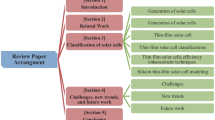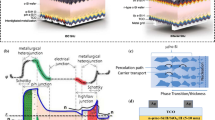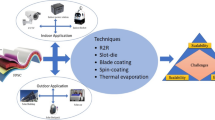Abstract
The effect of moderate hydrogen dilution of the process gas, F(H2)/F(SiH4) = 0 to 3, on the properties of amorphous silicon is discussed for material and solar cells deposited by Hot-Wire CVD. Dielectric properties were obtained from spectroscopic ellipsometry and are related to stability and hydrogen bonding configuration of films deposited with varying hydrogen dilution at different substrate temperatures. The stability was determined by comparing defect densities obtained from photoconductivity spectroscopy in the constant photocurrent mode (CPM) before and after pulsed-light soaking. At low substrate temperatures, which are relevant for the prepara- tion of pin-type solar cells (160-200°C), moderate hydrogen dilution (∼0.3) improves material quality regarding density and network disorder (oscillator bandwidth) as obtained from spectro-scopic ellipsometry, resulting in a higher stability. At higher substrate temperatures (300°C), stability and hydrogen bonding configurations are generally better, but moderate hydrogen dilu-tion already deteriorates these properties compared to material prepared without dilution. The incorporation of Hot-Wire-a-Si:H into pin-type solar cells is also discussed and a good correlation of ellipsometric results with bulk-related properties of solar cell performance is observed. The optimum hydrogen dilution is found to be 0 to 0.3 for i-layer deposition yielding initial efficiencies of up to 8.9% for solar cells entirely fabricated by Hot-Wire CVD.
Similar content being viewed by others
References
S. Bauer, B. Schröder, W. Herbst, and M. Lill, Proc. 2nd WCPVSEC (1998) p. 363.
Y. Ziegler, S. Dubail, Ch. Hof, U. Kroll, and A. Shah, Proc. 26th IEEE PVSC (1997) p. 687.
U. Weber, M. Koob, R.O. Dusane, C. Mukherjee, H. Seitz, and B. Schroeder, Proc. of the 16th EC PVSEC (2000) pp. 286–291.
A.H. Mahan, R.C. Reedy Jr, E. Iwaniczko, Q. Wang, B.P. Nelson, Y. Xu, A.C. Gallagher, H.M. Branz, R.S. Crandall, J. Yang, and S. Guha, in Amorphous and Microcrystalline Silicon Technology, edited by R. Schropp, H. M. Branz, M. Hack, I. Shimizu, and S. Wagner (Mat. Res. Soc. Symp. Proc. 507, 1998, San Francisco, CA, USA) pp. 119–124.
Q. Wang, E. Iwaniczko, Y. Xu, W. Gao, B.P. Nelson, A.H. Mahan, R.S. Crandall, and H.M. Branz, Mat. Res. Soc. Symp. Proc. 609 (2000), in press.
B. Stannowski, A.M. Brockhoff, A. Nascetti, and R.E.I. Schropp, J. Non-Cryst. Solids, 266-269, 464 (2000).
S. Guha, K. L. Narasimhan, and S. M. Pietruszko, J. Appl. Phys. 52, 859 (1981).
S. Wieder, B. Rech, C. Beneking, F. Siebke, W. Reetz, and H. Wagner, Proc. of the 13th EC-PVSEC (1995) p. 234.
S. Okamoto, Y. Hishikawa, and S. Tsuda, Jpn. J. Appl. Phys. 35, 26 (1996).
S. Bauer, B. Schröder, and H. Oechsner, J. Non-Cryst. Solids 227-230, 34 (1998).
A.S. Ferlauto, J. Koh, P.I. Rovira, C.R. Wronski, R.W. Collins, and G. Ganguly, J. Non-Cryst. Solids, 266-269, 269 (2000).
U. Weber, M. Koob, C. Mukherjee, D. Chandrashekhar, R. O. Dusane, and B. Schroeder, these Proceedings.
A. Matsuda, J. Non-Cryst. Solids, 59-60, 767 (1983).
G. E. Jellison Jr, and F. A. Modine, Appl. Phys. Lett. 69, 371 (1996); 69, 2137(E) (1996).
C.C. Tsai, R. Thompson, C. Doland, F.A. Ponce, G.B. Anderson, and B. Wacker in Amorphous Silicon Technology, edited by A. Madan, M.J. Thompson, P.C. Taylor, P.G. LeComber, and Y. Hamakawa (Mat. Res. Soc. Symp. Proc. 118, 1988, Reno, NV, USA) pp. 49–54.
G. Ganguly and A. Matsuda, J. Non-Cryst. Solids 198-200, 559 (1996).
H. Shirai, B. Drévillon, and I. Shimizu, Jpn. J. Appl. Phys. 33, 5590 (1994).
J. Doyle, R. Robertson, G.H. Lin, M.Z. He, and A. Gallagher, J. Appl. Phys. 64, 3215 (1988).
G. Yue, J.D. Lorentzen, J. Lin, D. Han, and Q. Wang, Appl. Phys. Lett. 75, 492 (1999)
Author information
Authors and Affiliations
Rights and permissions
About this article
Cite this article
Weber, U., Schroeder, B. The Effect of Moderate Hydrogen Dilution on Stability and Structure of Amorphous Silicon Deposited by Hot-Wire CVD. MRS Online Proceedings Library 664, 73 (2000). https://doi.org/10.1557/PROC-664-A7.3
Published:
DOI: https://doi.org/10.1557/PROC-664-A7.3




